Olympus M.Zuiko Digital ED 14-150mm f/4-5.6 Lens Review
Olympus M.Zuiko Digital ED 14-150mm f/4-5.6 Performance
At 14mm, sharpness in the centre of the frame is already outstanding at maximum aperture. Peak sharpness across the frame is achieved between f/5.6 and f/8 for this focal length where clarity is excellent towards the edges of the frame, while it remains outstanding in the centre.With the zoom set to 45mm, sharpness levels are still outstanding in the centre of the frame at maximum aperture and the lens performs excellently towards the edges of the frame. Peak sharpness across the frame is achieved at f/8 for this focal length and sharpness is outstanding from edge to edge.
Finally, at 150mm, there is a slight drop in performance, but sharpness is still excellent in the centre of the frame at maximum aperture and very good towards the edges of the frame.
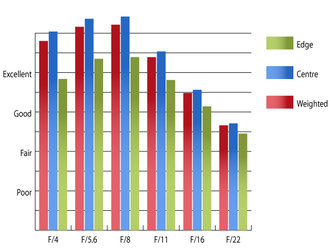 Resolution @ 14mm | 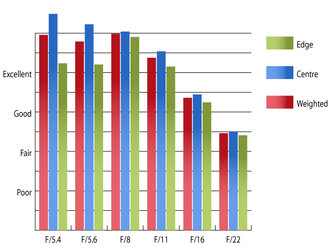 Resolution @ 45mm |
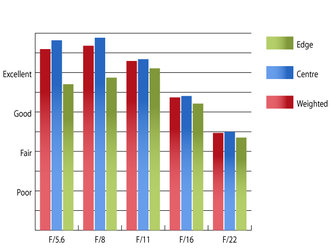 Resolution @ 150mm | How to read our chartsThe blue column represents readings from the centre of the picture frame at the various apertures and the green is from the edges. Averaging them out gives the red weighted column.The scale on the left side is an indication of actual image resolution. The taller the column, the better the lens performance. Simple. For this review, the lens was tested on aPanasonic Lumix G3 using Imatest. |
Chromatic aberrations are well controlled at all but the widest end of the zoom when stopped down. At 14mm, fringing starts to exceed one pixel width at f/11 and gets more severe as the aperture is stopped down.
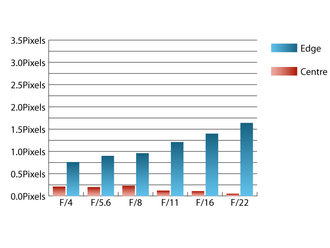 Chromatic aberration @ 14mm | 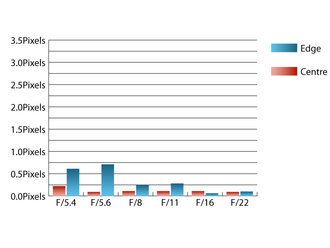 Chromatic aberration @ 45mm |
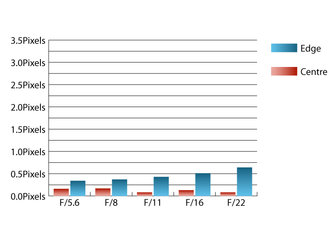 Chromatic aberration @ 150mm | How to read our chartsChromatic aberration is the lens' inability to focus on the sensor or film all colours of visible light at the same point. Severe chromatic aberration gives a noticeable fringing or a halo effect around sharp edges within the picture. It can be cured in software.Apochromatic lenses have special lens elements aspheric, extra-low dispersion etc. to minimize the problem, hence they usually cost more. For this review, the lens was tested on a Panasonic Lumix G3 using Imatest. |
Falloff of illumination towards the corners of the frame is constant throughout the zoom range. Corners are one stop darker than the image centre throughout the zoom range at maximum aperture. Visually uniform illumination is achieved with the aperture stopped down by one stop from maximum throughout the zoom range.
Distortion is very well controlled for a superzoom lens. Imatest detected 1.7% barrel distortion at 14mm and a negligible amount of pincushion at 150mm. This low level shouldn't pose many issues, but if absolutely straight lines are needed, you'll be glad to know that it should be relatively straightforward to correct as the distortion pattern is uniform across the frame.
No lens hood is supplied as standard with this lens, which is a shame. However, it is quite resistant to flare so a hood may not be required in many cases.
Add your message
Login required
Please login here or if you've not registered, you can register here. Registering is safe, quick and free.
Please login here or if you've not registered, you can register here. Registering is safe, quick and free.
photodo Stats
1102 lenses
428 MTF tests
74 in-depth photodo reviews
100+ users join each day
Help the lens community by reviewing or rating a lens today via our lens search
428 MTF tests
74 in-depth photodo reviews
100+ users join each day
Help the lens community by reviewing or rating a lens today via our lens search
Latest Lens Reviews
- Chinon 28mm f/2.8 Vintage Lens Review
- Canon EF 70-200mm f/4L IS II USM Lens Review
- Samyang AF 85mm f/1.4 EF Review
- Sigma 70mm f/2.8 DG Macro Art Review
- Samyang AF 24mm f/2.8 FE Review
- Meike 50mm f/1.7 Review
- Tamron 70-210mm f/4 Di VC USD Review
- Lensbaby Burnside 35mm f/2.8 Review
- Asahi Super Takumar 50mm f/1.4 Review
- Asahi Super-Multi-Coated Takumar 135mm f/3.5 Review
